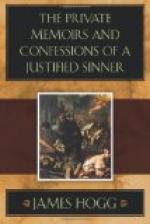|
This section contains 5,370 words (approx. 18 pages at 300 words per page) |

|
SOURCE: Glance, Jonathan C. “Ambiguity and Dreams in James Hogg's The Private Memoirs and Confessions of a Justified Sinner.” Studies in Scottish Literature, 28 (1993): 165-77.
In the following essay, Glance studies Hogg's use of dreams in The Private Memoirs and Confessions of a Justified Sinner to “reinforce the novel's central theme of ambivalence.”
Much recent critical attention to James Hogg's The Private Memoirs and Confessions of a Justified Sinner (1824) has recognized as central to the novel its tone of radical ambiguity.1 Critics tend to locate this ambiguity in two primary locations: the questionable reliability of the two inconsistent narratives, and the indeterminate existence of the mysterious character Gil-Martin. Yet another ambiguous element of the novel deserves attention—the various dreams and dream-like episodes which occur in the Confessions and which reinforce the fundamentally ambivalent dichotomy between rational and supernatural interpretations of the narratives. Hogg's use of literary dreams is...
|
This section contains 5,370 words (approx. 18 pages at 300 words per page) |

|


